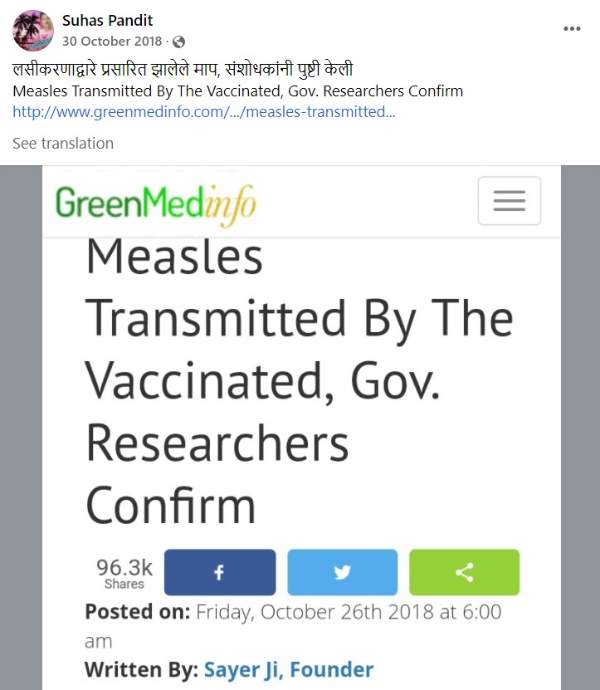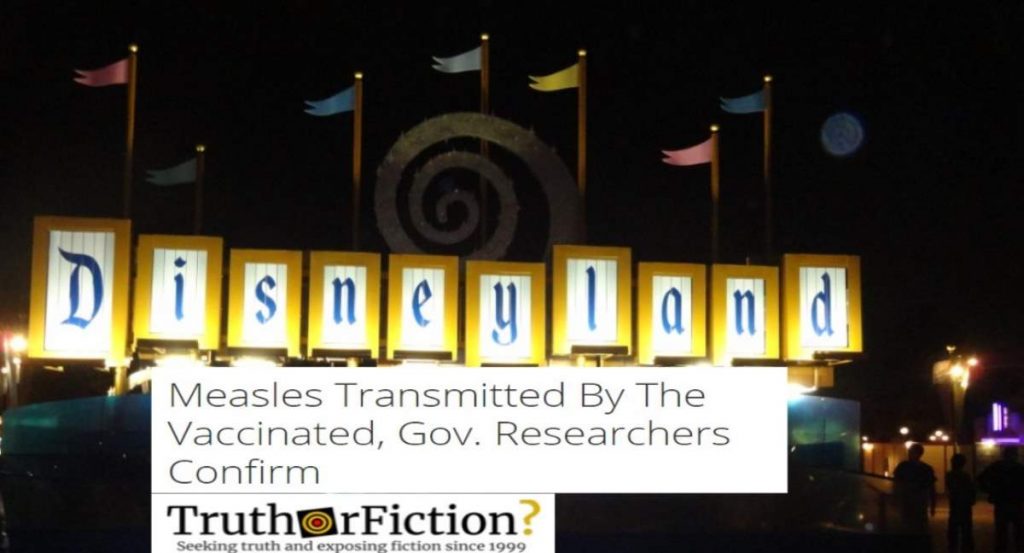A measles outbreak that was traced to an unvaccinated patron at the Disneyland theme park in late 2014 and early 2015 provided ample fodder for anti-vaccine blogs and social media users to push distortions or outright disinformation.
The blog “GreenMedInfo” — part of an ecosystem of websites that push what they call “natural medical information” — was among those that seized on the outbreak, which led to 147 cases of the disease.
One of the blog’s posts would spawn a chain email that, in keeping with the spread of online disinformation lingers in social media, sometimes as a photograph:

- “Patient zero” in the measles outbreak was immunized: Not True.
As of January 2022, no evidence has come to light showing that the first patient in the outbreak — a.k.a. “Patient zero” — was vaccinated against the disease at the time they caught it. According to the Centers for Disease Control’s (CDC) report on the outbreak:
On January 5, 2015, the California Department of Public Health (CDPH) was notified about a suspected measles case. The patient was a hospitalized, unvaccinated child, aged 11 years with rash onset on December 28. The only notable travel history during the exposure period was a visit to one of two adjacent Disney theme parks located in Orange County, California.
Of the 110 California-based patients recorded during the outbreak, the CDC reported, 45 percent were not vaccinated. Of those 45 patients, 12 were too young to be vaccinated when they contracted the disease, while 28 “were intentionally unvaccinated because of personal beliefs, and one was on an alternative plan for vaccination.”
A separate study by researchers published in March 2015 in the journal JAMA Pediatrics further found that vaccination rates related to the outbreak in some communities “might be as low as 50 percent and likely no higher than 86 percent.”
- 18 percent of measles cases occur in those who have been vaccinated against it: Decontextualized.
For this particular claim, the blog likely conflated the Disneyland outbreak with a separate rash of cases. According to the CDC’s report, only 1 of the 110 patients based out of California had received three doses of the vaccine covering measles, mumps, and rubella (the MMR vaccine for short); another seven patients had received two doses; and five had received just one dose.
In January 2015, the Los Angeles Times published a story making note of five cases of measles among “fully vaccinated” patients as part of the Disney outbreak. But the blog’s claim might have been prompted by a separate section of the article:
California’s last measles outbreak started [in 2014], also centered in Orange County, and involved residents returning from the Philippines with the disease. In that case, 18 percent of those who got sick had been immunized.
As this claim continues to spread online, another source of conflation could be a CDC report on measles cases in the U.S. between January and April 2019, when 704 cases were reported in 22 states:
Among all measles patients, 503 (71 percent) were unvaccinated, 76 (11 percent) were vaccinated (received ≥1 measles, mumps, and rubella (MMR) vaccine), and the vaccination status of 125 (18 percent) was unknown.
- It is “widely believed” that the measles-mumps-rubella (MMR) vaccine is 99 percent effective: Mixed.
According to the CDC, the MMR vaccine might not be exactly 99 percent effective:
One dose of MMR vaccine is 93 percent effective against measles, 78 percent effective against mumps, and 97 percent effective against rubella.
Two doses of MMR vaccine are 97 percent effective against measles and 88 percent effective against mumps.
“About 3 out of 100 people who get two doses of MMR vaccine will get measles if exposed to the virus,” the CDC has said. “However, they are more likely to have a milder illness, and are also less likely to spread the disease to other people.”
- A woman fully vaccinated against MMR was the source of four measles cases in New York City in 2011: True.
This claim is true — and also remarkably rare. The 22-year-old woman in question constituted the first recorded case involving that kind of transmission. Researchers reportedly found that despite containing antibodies in her blood, her body reacted as if it had never been vaccinated.
The CDC did track a mumps outbreak in 2019 that was traced to an “asymptommatic, fully vaccinated” attendee at a wedding in Nebraska. Sixty-two cases were linked to the patient, including 30 who attended the same wedding.
“The wedding served as a setting conducive to droplet transmission, facilitated by close social contact,” the agency’s report stated. “Isolation of ill persons and a communitywide MMR vaccination campaign helped end the outbreak.”
- Scientists have linked measles vaccinations to autism: Not True.
There is no evidence drawing a connection between measles vaccines and autism. This has been made clear by not only the CDC but the National Institutes of Health (NIH) and, as recently as May 2021, the United Nations group UNICEF, among others.
But blogs like “GreenMedInfo” were galvanized into pushing disinformation claiming otherwise by the work of Andrew Wakefield, who was published in the British medical journal The Lancet in 1998; Wakefield claimed that his work showed that the MMR vaccine was unsafe.
However, the journal retracted the study in February 2010. According to the New York Times:
A British medical panel concluded last week that Dr. Wakefield had been dishonest, violated basic research ethics rules and showed a “callous disregard” for the suffering of children involved in his research. Dr. Richard Horton, editor in chief of The Lancet, said that until that decision, he had no proof that Dr. Wakefield’s 1998 paper was deceptive.
“That was a damning indictment of Andrew Wakefield and his research,” Dr. Horton said.
In his study, Wakefield posited that the MMR vaccine was to blame for what was described as “chronic intestinal measles infections” in 12 children. But an investigation by the British General Medical Council (GMC) found that Wakefield had made 11 of his subjects undergo “invasive tests like lumbar punctures and colonoscopies that they did not need and for which he did not receive ethical approval.”
A separate investigation by reporter Brian Deer revealed that Wakefield had neglected to disclose financial conflicts of interest in his research, including a separate “vaccine” he patented in 1997, and funding he received from attorneys for parents who planned to sue vaccine makers.
Deer would go on to write an unauthorized biography of Wakefield, who remains known as the “father of the anti-vaccine movement.”
“The last I heard of him, he was shacked up in Miami, Florida, with a supermodel, divorced wife of a billionaire,” Deer wrote. “Which only goes to show that, once you’ve fooled all of the people some of the time, and some of the people all of the time, your next idea had better be good.”
The supermodel in question, Elle Macpherson, confirmed in December 2021 that she had broken up with Wakefield.
Over time, Wakefield’s legacy has played out with the continued spread of anti-vaccine disinformation. As the Harvard Political Review reported in August 2021:
Annual measles cases had risen to 991 in the U.K. and 83,540 in Europe by 2018. In the U.S., they rose to 1,282 in 2019, the largest outbreak since 1992. A 2019 article published in The Lancet identified one key factor behind the increasing number of cases: a reduction in coverage of the Measles-Mumps-Rubella vaccines due to lowered vaccine uptake. In response, U.K. Prime Minister Boris Johnson laid out a comprehensive plan to tackle the resurgent measles outbreak in 2019. One of the key factors for the faltering vaccine uptake numbers, he stated, was “all that anti-vax stuff” on the internet.
Likewise, Wakefield’s fellow travelers have adapted their rhetoric to continue spreading disinformation as the COVID-19 pandemic spread worldwide; as recently as January 2022, anti-vaccination “activists” held rallies on the National Mall attempting to cast themselves as the protagonists in their own civil rights campaign. As Rolling Stone reported:
Just days after the CDC released its first study showing vaccine boosters help protect patients against hospitalization from Omicron, Dr. Robert Malone, a virologist and well-known vaccine skeptic, falsely told the crowd: “The science is settled: they’re not working.”
Update 1/25/2022, 3:01 a.m. PST: This article has been revamped and updated. You can review the original here.
- Measles Outbreak — California, December 2014–February 2015
- Disneyland Measles Outbreak Confirmed to Be Linked to Low Vaccination Rates
- Substandard Vaccination Compliance and the 2015 Measles Outbreak
- Journal Retracts 1998 Paper Linking Autism to Vaccines
- The Doctor Who Fooled the World, by Brian Deer
- Elle Macpherson Confirms Split from Ex-Doctor Anti-Vaxxer Andrew Wakefield
- Autism and Vaccines
- Vaccine Safety: Myths and Misinformation
- The MMR Vaccine Does Not Cause Autism
- Year in Review: Measles Linked to Disneyland
- Disneyland Measles Outbreak: Cases Not Limited to the Unvaccinated
- Increase in Measles Cases – United States, January 1-April 26, 2019
- Measles, Mumps, and Rubella (MMR) Vaccination: What Everyone Should Know
- Why Did Vaccinated People Get Measles at Disneyland? Blame the Unvaccinated
- Measles Outbreak Traced to Fully Vaccinated Patient for First Time
- Multistate Mumps Outbreak Originating from Asymptomatic Transmission at a Nebraska Wedding — Six States, August–October 2019
- What Vaccine Misinformation Really Tells Us
- 'I'm a Full Anti-Vaxxer Now': How the Conspiracists Are Winning Over Fresh Converts

